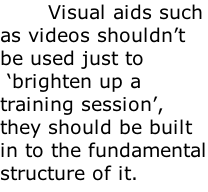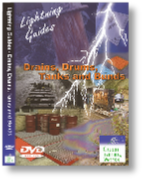






















Unfortunately videos are not always well used and the trainers involved have not been trained to train. The training function often falls, not on the shoulders of the HR experts but on those with other roles responsibilities. These roles might be in health and safety, environmental management, quality, project management, or any number of jobs where training is not the core function. Or you might have to wear several hats! If this sounds like you click here for tips and guidance.
Training might not be your preference, you might feel uncomfortable in front of an audience, you might not know it but you might have a dull presentation style or you simply might not have the time to do justice to your training responsibilities.
Look at it from the point of view of the audience. How many times have you sat struggling to hear the speaker, not able to make out the detail on the PowerPoint slide or hear the soundtrack on the video?
Have you waited patiently for the video to start while people fumble with wires, plugging and unplugging equipment or just waiting for the aging computer system to kick in to action. How often have you seen a video in a presentation and wondered afterwards “what was that about?”, “what was the point of it?” or “good graphics and music but it was weak on content”
From your earliest days at school and throughout your career you will have witnessed training and conference presentations that used visual aids of some kind - some good and some... not so good. Visual aids such as videos shouldn’t be used just to ‘brighten up a training session’, they should be built in to the fundamental structure of it.



It’s long been recognised (at least since the 1930’s) that the use of moving pictures in training sessions can greatly enhance learning outcomes. The technology has advanced significantly since those early days but the educational and training benefits are much the same.
A video can make small things big and big things small, it can cut across time and space, compress and expand time, show context and relationship and simplify details by removing and highlighting.
You could tell someone about how something functions; showing a picture or a diagram will help communicate your words but a video can demonstrate it in action.
A video is also consistent - you get the same message every time. The trainer may be having an off day, it may be down to a substitute trainer on occasions or for a whole host of reasons the training may be cut short or training points accidentally omitted. Not with a video – you get the same information repeated consistently every time - which brings an aspect of quality management into the exercise. Consistency is a foundation stone of quality management – you can’t manage chaos and inconsistency but you can manage regular and repeated processes.
Why use video?
Does this seem familiar?
You might also be interested in this article:
Presentation Tips for New Trainers
See all Features and Tips
You might also be interested in these products
Drains, Drums, Tanks, and Bunds
Spill!
Do What It Says On The Bin




One World is Not Enough


© Green Training Works
| Pollution Prevention |
| Waste |
| Awareness |
| Resource Efficiency |
| H&S, Energy and Other |
| Browse by Category |
| Browse by Cover |
| Directors Comments A Way With Waste |
| Director's comments |
| Presentation tips for new trainers |
| Green Training Views |
| Irony gets a hat |
| Why Use Video? |
| Unofficial Laws |
| ALL ARTICLES |
| Directors Comments |
| Scrapbook |
| Your Training Objectives |
| Training and Communications |
| Beware the price |
| Briefing |
| Pitfalls |
| Production Experience |
| CONTACT |